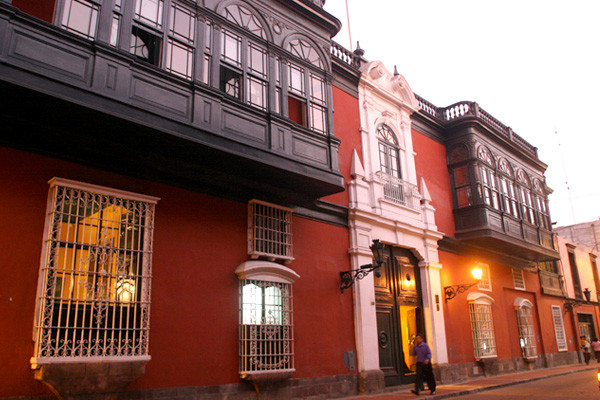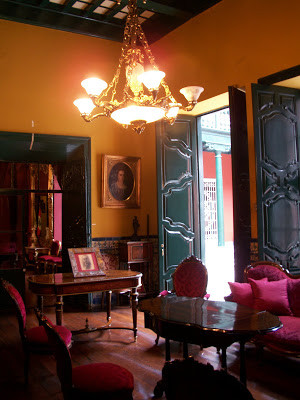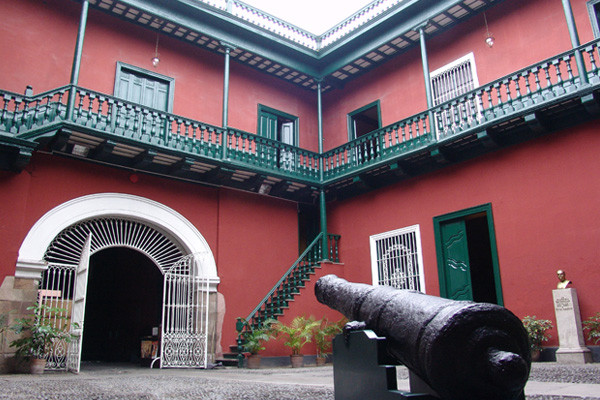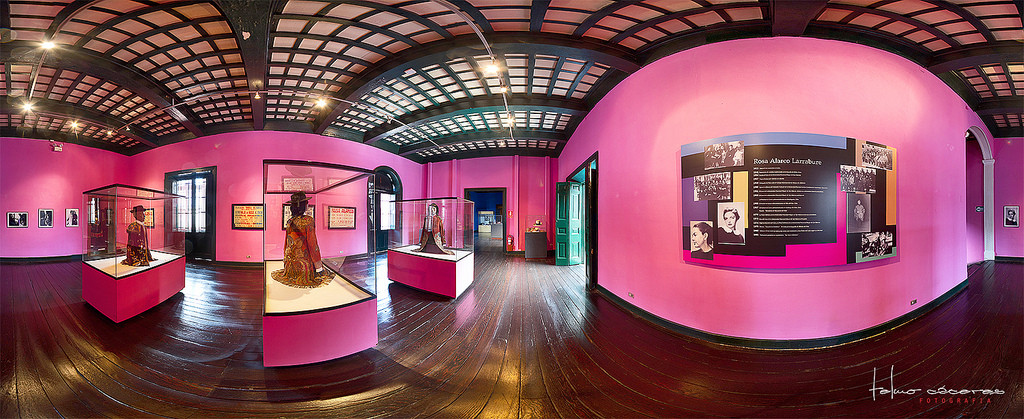Hello everybody! I hope that you are all well and that you are having an amazing day. Today I am going to talk to you about a cultural place in the heart of Lima on the street, 'jirón Camaná'. It is known as Casa Riva Agüero (House of the Riva Agüero family) and it is currently the cultural centre of the Pontifical Catholic University of Peru.
The best thing about the Riva Agüero house is that it is free, dear readers, so you can make the most of this cultural journey and go around the installations with a lot of history, without paying a single sole. There are a few paintings of the well known street jirón de la unión (the most important pedestrian street in the centre of Lima). A street with quite a lot of shops such as poultry shops, clothes shops, cinemas and above all, the second floors of most of the houses that preserve a history and a past which is not very well known to most people from Lima. However I will tell you about it, little by little, in future publications about the city where I was born.
Let's talk about its facade

Source
Like I said, the Riva Agüero House is located on the street, jirón Camana, on the fourth block. From the outside you will see a facade with two green republican style balconies, accompanied by their respective glass as well as their intense pink coloured front, almost like a wine shell with a green portico and it's white frames that reach the second floor of the building. This house was built with 18th century influences, where its large windows on the first floor face towards the street. It is decorated with wrought iron in the shape of a grid and with floral designs, divided up into three parts. This house also has something which will catch your attention and that is that none of its bars looks like the other, each one has a unique design and its brand is shown in a special and well decorated way.
A special details in this house is the entrance where you will find a courtyard that has a polished pebble floor as well as a small tank. The courtyard is in keeping with the rules of colonial Lima because in those times, it was not common to have gardens or courtyards but instead they had flowerpots, which gave a little more life to the place. In addition, these places also became a public part of the city of Lima, since it was there that the town criers came to sell their products to the inhabitants of the house, using traditional songs at certain times. For example in the morning when the baker came to sing, you would know what time it was without even needing a clock. What is it like today? Well thanks to the different stories that authors like Ricardo Palma and graphic representations like those of Pancho Fierro, we have been able to discover the different characters the different characters of Lima's colonial era, who no longer exist.
The origins of the house
I am going to tell you that the house is almost 250 years old and was built around 1760, when Lima was still colonial. It was built by a Spanish shopkeeper and until the 20th century it was a family residence, the last of its inhabitants being Sr. Riva Agüero. After his death, he donated his properties to the Pontifical Catholic University of Peru, where it still remains today as the cultural centre. In addition, he donated a very large piece of land to the same university, which today is very close to the San Miguel district, by the university avenue, which is where you will find this university and the National University of San Marcos, where I studied tourism.
As I mentioned at the start, this house is in keeping with the rules on construction of colonial Lima. It starts with the zaguan (a kind of house plan), then with the roman courtyard and then another courtyard which has more of a Seville style. It has two floors which was the maximum that you were allowed in houses in Lima in order to avoid any disasters due to earthquakes, which happened very often in Lima due to the geographical placement in the pacific.
The main courtyard welcomes it's guests. We are going to be able to see the marble stairs and the black and white floor tiles as if they are a chess board which gives the place a simple and beautiful harmony.
A house in Lima with it's own chapel
When I first entered the house, I was amazed to know that they also had a family chapel like the Aliaga house, where there is a painting of the crucified Jesus Christ and a sculpture of the Virgin Mary with the baby Jesus, covered in gold leaves. Anyway, despite being surprised I am going to tell you that for me the most beautiful family chapel is still the chapel of the Aliaga house because of its decorations and because it is more overloaded than the one in the Riva Agüero house. Although of course I recognise that they are true works of art and that all of Lima is a museum with so many things to earn about and enjoy.
Another thing that you will also notice in the Riva Agüero house is its well preserved furniture such as shelves, tables and chairs. To give a little more history about my city, I will tell you that at the minute, the unique houses that have kept their antique furniture are the Aliaga house, the Prado house and the Riva Agüero house. Which one do you prefer? Visit all of them and be amazed by all of the options that there are in Lima.
A house with traces of modernity

Source
Another strange thing that I am going to share with you is that the house was one of the first houses in Lima to have electricity, soon the tour, you can see some of the connections for the electricity that already existed at the end of the 19th century. All thanks to the management of the president Ramón Castilla, who has a statue dedicated to him very close to the house, in front of the church called "La Merced". This president is very well known in Peruvian history because not only did he make all of these important changes at the time, but also brought freedom to the black slaves of Peru. They is even a song that says, "Que viva Ramón Castilla, que nos dio la libertad”, (Long live Ramón Castilla, who gave us freedom) to afro Peruvian style music, in honour of the president who abolished slavery. It was after many years that the promise was made to the slaves which gave them the right to be free, during the time of the Spanish war of independence.
The house library
Luckily those of us who like to read because here in the house Riva Agüero, we have access to a juicy collection of artistic works. This library, named Victor Andrés Belaunde, is open to the public and this is where I have been able to find so much information about the houses in Lina and the art from my whole city which fills me with so much pride. The ceiling of this library is carved as well as it having paintings of Saint Rose of Lima, one of the most recognised in my city.
On the other hand, the house also has a valuable newspaper library. In this case if you must have a special permission to access the extensive information found there. One thing found there is, for example, the first edition of the newspaper “El Comercio”, the oldest newspaper in Peru. Today, when I am far from my city, I always check it's website and although this newspaper is not completely unbiased, I cannot discredit it for being one of the most famous newspapers in Peru.
The history of the cannons

Source
Dear readers I want to share with you that inside the Riva Agüero house, you will also find two cannons which to your surprise were found in the excavations during the restoration process and today the cannons are to one side of the courtyard as a decorative feature. Now what I can tell you is that these cannons were not to be used in times of war but were simply placed as ornaments used by the inhabitants of those days, so it is not what it seems!
Another thing you will understand by visiting the Riva Agüero house is that the family had their bedrooms on the second floor and the first floor was considered as the social part to host their guests and traders who came to sell their products. The doors of houses in Lima such as Riva Agüero almost always stayed open and these courtyards, that I told you about initially, where part of the streets of Lima, making them a public space!
The museum of popular art and traditions

Source
Today, thanks to the restoration process, initiated by the Pontifical Catholic university of Peru, the Riva Agüero Institute has installations from the Museum of popular art and traditions on the second floor. Here you can not only see different colonial works of art but also popular art, which is one of my favourites. For example, the beautiful Pucara bulls from the Puno area, as well as sculptures and carvings which makes the tour a didactic way of understanding that Peru is a multicultural country and that we have have some great wonders which are still being created thanks to the blessed hands of our craftsmen. You already know what I am going to say dear readers, add it to the schedule! And come and see the rooms of this fascinating museum.
In the museum there are approximately 10 thousand pieces as well as artistic photographs. Who said art is boring? Not at all! Here you can see it with your own eyes.
The Museum is always changing its exhibits to make them enjoyable to each of its inhabitants and every time you come you will find it renovated and with a wide variety of taste.
Now to conclude, dear readers, I will include the opening hours:
From Monday to Friday, 10:00 to 13:00 and from 14:00 until 20:00. Saturdays from 14:00 to 17:00.
Entry: Free!
Experience: Motivating and enriching 1000 points
I hope that you have enjoyed this journey and experience and that that you are encouraged you travel around in like I am. A gem of Lima that is waiting for you!
Thank you very much for reading this experience with me, there will be another opportunity. Until next time Lima-lovers!
